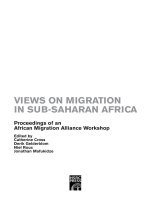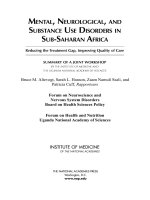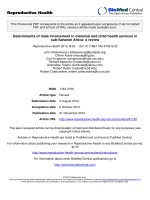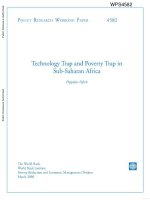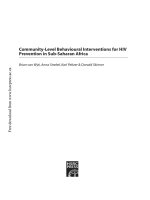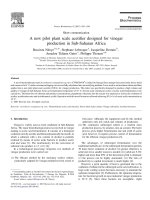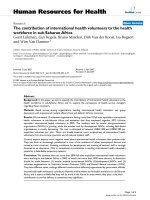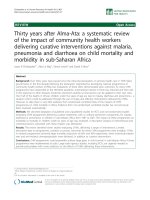The skills balancing act in sub saharan africa
Bạn đang xem bản rút gọn của tài liệu. Xem và tải ngay bản đầy đủ của tài liệu tại đây (12.45 MB, 381 trang )
Public Disclosure Authorized
blic Disclosure Authorized
Public Disclosure Authorized
Public Disclosure Authorized
A FRIC A DEV EL OPM ENT FORUM
The Skills Balancing Act
in Sub-Saharan Africa
Investing in Skills for Productivity,
Inclusivity, and Adaptability
Omar Arias, David K. Evans, and Indhira Santos
The Skills Balancing Act
in Sub-Saharan Africa
The Skills Balancing Act
in Sub-Saharan Africa
Investing in Skills for
Productivity, Inclusivity,
and Adaptability
Omar Arias, David K. Evans, and
Indhira Santos
A copublication of the Agence franỗaise de dộveloppement and the World Bank
© 2019 International Bank for Reconstruction and Development / The World Bank
1818 H Street NW, Washington, DC 20433
Telephone: 202-473-1000; Internet: www.worldbank.org
Some rights reserved
1 2 3 4 22 21 20 19
This work is a product of the staff of The World Bank with external contributions. The findings, interpretations,
and conclusions expressed in this work do not necessarily reflect the views of The World Bank, its Board of
Executive Directors, or the governments they represent, or the Agence franỗaise de dộveloppement. The World
Bank does not guarantee the accuracy of the data included in this work. The boundaries, colors, denominations,
and other information shown on any map in this work do not imply any judgment on the part of The World Bank
concerning the legal status of any territory or the endorsement or acceptance of such boundaries.
Nothing herein shall constitute or be considered to be a limitation upon or waiver of the privileges and immunities
of The World Bank, all of which are specifically reserved.
Rights and Permissions
This work is available under the Creative Commons Attribution 3.0 IGO license (CC BY 3.0 IGO) http://creative
commons.org/licenses/by/3.0/igo. Under the Creative Commons Attribution license, you are free to copy, distribute, transmit, and adapt this work, including for commercial purposes, under the following conditions:
Attribution—Please cite the work as follows: Arias, Omar, David K. Evans, and Indhira Santos. 2019. The Skills
Balancing Act in Sub-Saharan Africa: Investing in Skills for Productivity, Inclusivity, and Adaptability. Africa
Development Forum series. Washington, DC: World Bank. doi:10.1596/978-1-1149-4. License: Creative Commons
Attribution CC BY 3.0 IGO
Translations—If you create a translation of this work, please add the following disclaimer along with the
attribution: This translation was not created by The World Bank and should not be considered an official World Bank
translation. The World Bank shall not be liable for any content or error in this translation.
Adaptations—If you create an adaptation of this work, please add the following disclaimer along with the attribution: This is an adaptation of an original work by The World Bank. Views and opinions expressed in the adaptation
are the sole responsibility of the author or authors of the adaptation and are not endorsed by The World Bank.
Third-party content—The World Bank does not necessarily own each component of the content contained within
the work. The World Bank therefore does not warrant that the use of any third-party-owned individual component
or part contained in the work will not infringe on the rights of those third parties. The risk of claims resulting from
such infringement rests solely with you. If you wish to reuse a component of the work, it is your responsibility to
determine whether permission is needed for that reuse and to obtain permission from the copyright owner.
Examples of components can include, but are not limited to, tables, figures, or images.
All queries on rights and licenses should be addressed to World Bank Publications, The World Bank Group,
1818 H Street NW, Washington, DC 20433, USA; e-mail:
ISBN (paper): 978-1-4648-1149-4
ISBN (electronic): 978-1-4648-1350-4
DOI: 10.1596/978-1-4648-1149-4
SKU: 211149
Cover photo: ©PeopleImages / istockphoto.com. Used with permission of istockphoto.com. Further permission
required for reuse.
Cover design: Bill Pragluski, Critical Stages, LLC.
Library of Congress Cataloging-in-Publication Data
Names: Arias, Omar, author. | Evans, David K., 1975- author. | Santos,
Indhira, author.
Title: The skills balancing act in Sub-Saharan Africa : investing in skills
for productivity, inclusivity, and adaptability / by Omar Arias, David K.
Evans, Indhira Santos.
Description: Washington, D.C. : World Bank, 2019. | Series: Africa
development forum series | Includes bibliographical references. |
Identifiers: LCCN 2019019314 (print) | LCCN 2019021656 (ebook) | ISBN
9781464813504 (electronic) | ISBN 9781464811494 (pbk.)
Subjects: LCSH: Labor supply--Africa, Sub-Saharan. | Vocational
education--Africa, Sub-Saharan. | Vocational qualifications--Africa,
Sub-Saharan.
Classification: LCC HD5837.A6 (ebook) | LCC HD5837.A6 A75 2019 (print) | DDC
331.1140967--dc23
LC record available at />
Africa Development Forum Series
The Africa Development Forum Series was created in 2009 to focus on
issues of significant relevance to Sub-Saharan Africa’s social and economic
development. Its aim is both to record the state of the art on a specific topic and
to contribute to ongoing local, regional, and global policy debates. It is designed
specifically to provide practitioners, scholars, and students with the most up-todate research results while highlighting the promise, challenges, and opportunities that exist on the continent.
The series is sponsored by Agence franỗaise de dộveloppement and the
World Bank. The manuscripts chosen for publication represent the highest
quality in each institution and have been selected for their relevance to the
development agenda. Working together with a shared sense of mission and
interdisciplinary purpose, the two institutions are committed to a common
search for new insights and new ways of analyzing the development realities of
the Sub-Saharan Africa region.
Advisory Committee Members
Agence franỗaise de dộveloppement
ã Gaởl Giraud, Chief Economist
ã Thomas Melonio, Executive Director, Research and Knowledge Directorate
• Pierre Icard, Director, Head of Knowledge Department on Sustainable
Development
• Sophie Chauvin, Head, Edition and Publication Division
• Hélène Djoufelkit, Deputy Head, Economic Assessment and Public Policy
Department
World Bank
• Albert G. Zeufack, Chief Economist, Africa Region
• Markus P. Goldstein, Lead Economist, Africa Region
v
vi Africa Development Forum Series
Sub-Saharan Africa
MAURITANIA
CABO
VERDE
NIGER
MALI
THE GAMBIA
GUINEA-BISSAU
GUINEA
BURKINA FASO
BENIN
CÔTE GHANA
D’IVOIRE
SIERRA LEONE
LIBERIA
NIGERIA
TOGO
CAMEROON
CENTRAL
AFRICAN REPUBLIC
ETHIOPIA
SOUTH
SUDAN
EQUATORIAL GUINEA
SÃO TOMÉ AND PRÍNCIPE
ERITREA
SUDAN
CHAD
SENEGAL
SOMALIA
UGANDA KENYA
REP. OF
GABON CONGO
DEMOCRATIC
REPUBLIC
OF CONGO
RWANDA
BURUNDI
TANZANIA
SEYCHELLES
COMOROS
ANGOLA
ZAMBIA
MALAWI
ZIMBABWE MOZAMBIQUE
NAMIBIA
ESWATINI
IBRD 39088 | MAY 2019
MADAGASCAR
MAURITIUS
La Réunion
(Fr.)
BOTSWANA
SOUTH
AFRICA
Mayotte
(Fr.)
LESOTHO
Titles in the Africa Development Forum Series
Africa’s Infrastructure: A Time for Transformation (2010) edited by Vivien Foster
and Cecilia Briceño-Garmendia
Gender Disparities in Africa’s Labor Market (2010) edited by Jorge Saba Arbache,
Alexandre Kolev, and Ewa Filipiak
Challenges for African Agriculture (2010) edited by Jean-Claude Deveze
Contemporary Migration to South Africa: A Regional Development Issue (2011)
edited by Aurelia Segatti and Loren Landau
* Light Manufacturing in Africa: Targeted Policies to Enhance Private Investment
and Create Jobs «L’industrie légère en Afrique: Politiques ciblées pour susciter
l’investissement privé et créer des emplois» (2012) by Hinh T. Dinh, Vincent
Palmade, Vandana Chandra, and Frances Cossar
* Informal Sector in Francophone Africa: Firm Size, Productivity, and Institutions
«Le système d’approvisionnement en terres dans les villes d’Afrique de l’Ouest:
L’exemple de Bamako» (2012) by Nancy Benjamin and Ahmadou Aly Mbaye
* Financing Africa’s Cities: The Imperative of Local Investment «Financer les villes
d’Afrique: L’enjeu de l’investissement local» (2012) by Thierry Paulais
* Structural Transformation and Rural Change Revisited: Challenges for Late
Developing Countries in a Globalizing World, «Transformations rurales et développement: Les défis du changement structurel dans un monde globalisé» (2012)
by Bruno Losch, Sandrine Fréguin-Gresh, and Eric Thomas White
The Political Economy of Decentralization in Sub-Saharan Africa: A New
Implementation Model (2013) edited by Bernard Dafflon and Thierry Madiès
Empowering Women: Legal Rights and Economic Opportunities in Africa (2013)
by Mary Hallward-Driemeier and Tazeen Hasan
Enterprising Women: Expanding Economic Opportunities in Africa (2013) by
Mary Hallward-Driemeier
Urban Labor Markets in Sub-Saharan Africa (2013) edited by Philippe De
Vreyer and Franỗois Roubaud
Securing Africas Land for Shared Prosperity: A Program to Scale Up Reforms and
Investments (2013) by Frank F. K. Byamugisha
* Youth Employment in Sub-Saharan Africa «L’emploi des jeunes en Afrique
subsaharienne» (2014) by Deon Filmer and Louise Fox
Tourism in Africa: Harnessing Tourism for Growth and Improved Livelihoods (2014)
by Iain Christie, Eneida Fernandes, Hannah Messerli, and Louise Twining-Ward
vii
viii Titles in the Africa Development Forum Series
* Safety Nets in Africa: Effective Mechanisms to Reach the Poor and Most
Vulnerable «Les filets sociaux en Afrique: Méthodes efficaces pour cibler les
populations pauvres et vulnérables en Afrique» (2015) edited by Carlo del
Ninno and Bradford Mills
* Land Delivery Systems in West African Cities: The Example of Bamako,
Mali «Le système d’approvisionnement en terres dans les villes d’Afrique de
l’Ouest: L’exemple de Bamako» (2015) by Alain Durand-Lasserve, Maÿlis
Durand-Lasserve, and Harris Selod
Enhancing the Climate Resilience of Africa’s Infrastructure: The Power and Water
Sectors (2015) edited by Raffaello Cervigni, Rikard Liden, James E. Neumann,
and Kenneth M. Strzepek
* Africa’s Demographic Transition: Dividend or Disaster? «La transition
demographique de l’Afrique» (2015) edited by David Canning, Sangeeta Raja,
and Abdo S. Yazbeck
The Challenge of Fragility and Security in West Africa (2015) by Alexandre Marc,
Neelam Verjee, and Stephen Mogaka
Highways to Success or Byways to Waste: Estimating the Economic Benefits of
Roads in Africa (2015) by Ali A. Rubaba, Federico Barra, Claudia Berg, Richard
Damania, John Nash, and Jason Russ
Confronting Drought in Africa’s Drylands: Opportunities for Enhancing Resilience
(2016) edited by Raffaello Cervigni and Michael Morris
* Reaping Richer Returns: Public Spending Priorities for African Agriculture
Productivity Growth, «Obtenir de meilleurs résultats : Priorités en matière de
dépenses publiques pour les gains de productivité de l’agriculture africaine»
(2017) by Aparajita Goyal and John Nash
Mining in Africa: Are Local Communities Better Off? (2017) by Punam ChuhanPole, Andrew L. Dabalen, and Bryan Christopher Land
Realizing the Full Potential of Social Safety Nets in Africa (2018) edited by
Kathleen Beegle, Aline Coudouel, and Emma Monsalve
Facing Forward: Schooling for Learning in Africa (2018) by Sajitha Bashir,
Marlaine Lockheed, Elizabeth Ninan, and Jee-Peng Tan
Electricity Access in Sub-Saharan Africa: Uptake, Reliability, and C
omplementary Factors for Economic Impact (2019) by Moussa P. Blimpo and Malcolm Cosgrove-Davies
The Skills Balancing Act in Sub-Saharan Africa: Investing in Skills for Productivity, Inclusivity, and Adaptability (2019) by Omar Arias, David K. Evans, and
Indhira Santos
* Available in French
All books in the Africa Development Forum series are available for free at
/>
Contents
Forewordxix
Acknowledgmentsxxi
About the Authors
xxv
Abbreviationsxxix
Executive Summary
1
Policy Framework for Skills Investments in Sub-Saharan Africa
1
Facing the Skills Balancing Act
4
Focus on Foundational Skills
4
Invest in the Technical Skills of Youth and Adults
8
Enact Systemwide Change and Make Skills Building
Everyone’s Business
14
Conclusions15
References16
Overview17
Omar Arias, David K. Evans, and Indhira Santos
Summary17
Challenges and Opportunities for Skills Building in
Sub-Saharan Africa
19
Policy Framework for Skills Investments in Sub-Saharan Africa
21
The Skills Balancing Act
24
Facing the Skills Balancing Act: How Can Countries in
Sub-Saharan Africa Improve the Skills of Their Labor Force for
Today and Tomorrow?
46
ix
x Contents
Conclusions66
Note67
References67
1 Skills and Economic Transformation in Sub-Saharan Africa
Omar Arias
71
Introduction72
Skills for Africa: Which Skills, When to Develop Them, and for Whom
74
Skills Wanted: The Demand for Skills in Sub-Saharan Africa Today
80
Skills and Economic Transformation in Sub-Saharan Africa
99
The Progress in Skills Development in Sub-Saharan Africa
108
Public Spending on Education in Sub-Saharan Africa
111
Skills Priorities for Sub-Saharan Africa: A Framework and
Country Typology
115
Notes122
References122
2 Developing Universal Foundational Skills in
Sub-Saharan Africa
Moussa Pouguinimpo Blimpo, David K. Evans, and Mũthoni Ngatia
129
Looking Back: The Evolution of Access and Equity in Formal
Skills Development in Sub-Saharan Africa
130
Looking Forward: The Future of Access and Equity in Formal
134
Skills Development
Quality: The Need to Deliver Actual Learning
136
Why Children Are Not Learning
139
How to Get It Right
147
The Way Forward
162
Notes163
References164
3 Building Skills for the School-to-Work Transition in
Sub-Saharan Africa
Indhira Santos, Daniel Alonso Soto, and Shobhana Sosale
Skills Acquisition for the School-to-Work Transition through
Technical and Vocational Education and Training
The Landscape of TVET in Sub-Saharan Africa
175
175
182
Contents xi
Policy Challenges in Preemployment TVET
192
Roadmap for TVET Reform
219
Notes224
References
226
4 Building Skills for Productivity through Higher
Education in Sub-Saharan Africa
Indhira Santos and Omar Arias
233
Introduction233
University Education in Sub-Saharan Africa
238
Improving Equity in Access to Higher Education
242
Ensuring Value for Money and Improved Efficiency
245
Achieving Higher Quality and Relevance
252
Prioritizing Investments and Managing the Expansion of
Higher Education in Sub-Saharan Africa
267
Conclusions292
Notes294
References296
5 Addressing Skills Gaps: Continuing and Remedial
Education and Training for Adults and Out-of-School
Youths in Sub-Saharan Africa
Mũthoni Ngatia and Jamele Rigolini
303
Introduction304
Continuing Education and Training
308
Addressing Skills Gaps of Poor and Vulnerable Workers: Remedial
Education and Training
315
Training Programs Supporting Self- and Wage Employment
330
What’s Next? Toward a Roadmap for Effective Continuing and
Remedial Education and Training Policies in Africa
335
Notes341
References341
Boxes
O.1
O.2
Strengthening Strategic Sectors through Training
Training in Personal Initiative
58
64
xii Contents
1.1
1.2
1.3
1.4
2.1
2.2
2.3
2.4
2.5
2.6
2.7
2.8
2.9
3.1
3.2
3.3
3.4
3.5
3.6
3.7
3.8
4.1
4.2
4.3
4.4
4.5
The Importance of Socioemotional Skills
75
Developing Higher-Order Skills
76
Values Attached to Children’s Socioemotional Qualities:
The World Values Surveys
94
Jobs, Tasks, and Changes in Demand for Skills in the
Digital Global Economy
106
The Megatrends and Foundational Skills
135
Stunting in Africa: What It Costs and How to Reduce It
142
How to Decide Which Early Child Investments Will Work
Best in Context? Test Them
149
Using Bicycles to Achieve Gender Parity in Access to
Secondary School
152
Bringing Parents and Communities Along
153
Getting the Right Teachers into the School System
154
How to Deliver Socioemotional Skills in Low-Income
Environments157
Are Private Schools the Answer?
157
Public-Private Partnerships in Secondary Schools
159
Megatrends and Skills Building through TVET
180
Benchmarking TVET Systems: The Systems Approach for
Better Education Results
193
Educate!: Bringing Entrepreneurship into Classrooms
204
Engaging the Private Sector in Building Skills for Catalytic
Sectors: Lessons from Singapore
205
Leveraging the Private Sector in Sub-Saharan Africa for Skills
Development in TVET
207
What Defines High-Quality Apprenticeships?
210
Moving toward a Task-Based Approach to Training:
The Generation Program
218
Five Building Blocks for TVET Reform in Sub-Saharan Africa 219
The Megatrends and Higher Education
234
When Students Go Abroad for University Studies
248
Brazil’s Targeted Tertiary STEM Expansion
265
Leveraging New Partners and Regional Collaboration: PASET
270
Leveraging the Private Sector for STEM: Science and
Technology Education Post-Basic Program in Nigeria
272
Contents xiii
4.6
4.7
4.8
5.1
5.2
5.3
5.4
5.5
5.6
5.7
5.8
5.9
5.10
Chile’s Performance-Based Agreements: Using Financing to
Steer Reforms
Paying for Results in Higher Education in Africa:
The Experience of Mali and the African Centers of Excellence
Expanding University Education: Lessons from the
Latin American Experience
Megatrends and Continuing and Remedial Education
National Training Funds
Adults Do Learn—Although Differently
Adapting Training and Employment Programs to
Gender-Specific Needs
The Kha Ri Gude (Let Us Learn) Adult Literacy Program,
South Africa
The Saakshar Bharat Adult Literacy Program, India
Agricultural Extension Programs
Public Works and Training in Côte d’Ivoire
A Private Sector Self-Sustained Initiative: Cape Town’s
Feel Good Project
Tailoring Programs to People: The Importance of Profiling
278
279
290
306
314
316
320
323
325
326
329
331
336
Figures
ES.1
O.1
O.2
O.3
O.4
O.5
O.6
O.7
Policy Framework for Skills Policy Priorities in
Sub-Saharan Africa
Policy Framework for Skills Policy Priorities in
Sub-Saharan Africa
Sectoral Distribution of Employment in Sub-Saharan Africa
Share of Firms Rating Skills as a Greater-than-Average
Constraint Compared with 14 Other Business Environment
Factors in Sub-Saharan Africa and the World, by Size of Firm
and GDP per Capita
Relative Returns to TVET and Higher Education in
Ghana and Kenya
Workforce Development Performance across Specific Policy
Goals, by Region
Megatrends That Shape Skills Demand in Sub-Saharan Africa
Educational Pyramids in Sub-Saharan Africa and Other Regions,
1950 and 2010
3
22
26
27
29
30
31
36
xiv Contents
O.8
Projected Gap in Educational Attainment of the Workforce in
Sub-Saharan Africa and Other Regions
37
O.9
Child Stunting Rates in Sub-Saharan Africa
39
O.10 Foundational Skills, Earnings, and Productivity in
Sub-Saharan Africa
42
O.11 Spending on Education as a Share of GDP and Total Spending,
by Region
43
O.12 Skills Challenges in Sub-Saharan Africa, by Countries’ Stage of
Economic Transformation and Policy Environment
48
B1.2.1 A Revision of Bloom’s Taxonomy of Learning
76
1.1
Flow and Stock of Skills Development over the Life Cycle
78
1.2
Share of Firms Rating Workforce Skills as a Greater-thanAverage Constraint Compared with 14 Other Business
Environment Factors in Sub-Saharan Africa and the World,
by Size of Firm and GDP per Capita
81
1.3
Share of Firms Rating Workforce Skills as a Greater-thanAverage Constraint Compared with 14 Other Business
Environment Factors in Sub-Saharan Africa, by GDP per Capita 82
1.4
Share of Firms Rating Workforce Skills and Other Business
Environment Factors as a Greater-than-Average Constraint in
Sub-Saharan Africa and the World
83
1.5
Share of Employers Rating the Skill as Important or Very
Important in Benin, Liberia, Malawi, and Zambia
84
Average Returns to Education for Wage Employment in
1.6
Sub-Saharan Africa, circa 2010
86
1.7
Contribution of Literacy Skills and On-the-Job Learning to
Earnings in Sub-Saharan Africa
89
1.8
Correlation between Socioemotional Skills and Farm
Productivity in Sub-Saharan Africa
92
1.9
Average Valuation of Children’s Socioemotional Qualities in
Sub-Saharan Africa and Other Regions
93
1.10 Relationship between the Valuation of Children’s Socioemotional
Qualities and Countries’ Level of Development
96
1.11 Families and Socioemotional Skills: Policy Levers
98
1.12 Urbanization in Sub-Saharan Africa and the Rest of the World,
by GDP per Capita
101
1.13 Impact of Digital Technologies on the Skills Intensity of
Employment in Select Countries
103
Contents xv
1.14
Peak in Share of Employment in Manufacturing, by Year and
GDP per Capita
104
1.15
Share of Agricultural Employment and Sectoral Distribution of
Employment in Sub-Saharan Africa and the World
105
1.16
Evolution of Educational Pyramids in Sub-Saharan Africa and
Other Regions, 1950 and 2010
109
1.17
Projected Gap in Educational Attainment of the Workforce in
Sub-Saharan Africa and Other Regions
110
1.18
Average Public Spending on Education in Sub-Saharan Africa
and Other Regions
111
1.19
A Framework for Skills Policy Priorities in Sub-Saharan Africa
116
1.20
Skills Challenges in Sub-Saharan Africa, Educational
Achievement, by Countries’ Stage of Economic Transformation
and Policy Environment
119
2.1
Basic Education Completion Rates in Sub-Saharan Africa,
1971–2013130
2.2
Access to Education in Ghana, Niger, and Uganda, 1965–2010
131
2.3
Projected Educational Attainment of the Adult Population
across Africa, 2010–40
134
2.4
Proportion of Pupils Performing below a Sufficient Competency
Threshold on Math and Language in Francophone Africa
137
2.5
Proportion of Second-Grade Students Who Cannot Read a
Single Word of Connected Text in Select Countries
138
2.6
Average Pass Rates on Tests of Both Literacy and Numeracy in
Kenya, Tanzania, and Uganda, by Household Poverty Level for
All Children Ages 10 and Above
138
2.7
Stunting Rates among Children under Five across Countries
140
2.8
Prevalence of Stunting in Children under Five across Countries
and Wealth Groups
141
B2.2.1 Reductions in Stunting in Select Countries
143
2.9
Teacher Knowledge across Sub-Saharan Africa
144
2.10
Teacher Attendance across Africa
145
2.11
Teacher Beliefs about Students’ Math Ability
145
2.12
Which Countries Have Made the Largest Gains in Enrollment in
the Last 20 Years?
151
3.1
Youths’ School-to-Work Transition in Select
Sub-Saharan African Countries, circa 2014
177
xvi Contents
3.2
3.3
3.4
3.5
3.6
3.7
3.8
3.9
3.10
3.11
4.1
4.2
4.3
4.4
4.5
4.6
4.7
Number of Youths (Ages 15–24) with at Least Secondary
TVET in Select Sub-Saharan African Countries, 2015–40
178
Correlation between TVET Enrollment at the Secondary
Level and GDP per Capita over Time and across Countries
182
Enrollment in Secondary-Level TVET, by Region and in
Sub-Saharan African Countries
183
Share of Adults Ages 25–34 Who Report Ever Having Been in
an Internship or Apprenticeship in Select Sub-Saharan African
Countries
185
Returns to General Education and to TVET in Wage
Employment Early in the School-to-Work Transition for
Workers in Select Sub-Saharan African Countries
186
Potential Hourly Earnings in Ghana and Kenya, by Track and
Estimated Percentile of Earnings
187
Odds Ratios of the Probability of Attending Secondary-Level
TVET versus General Secondary in Ghana and Kenya
188
Relative Returns to TVET in Kenya and Ghana, by Field of Study 189
Earnings over the Life Cycle as a Percentage of Earnings
of an Average Earner with at Most a Completed Primary
Education in Kenya and Ghana
190
Relative Performance of African Countries on TVET
194
Returns to Tertiary Education, by Region and Select
Sub-Saharan African Countries
237
Gross Enrollment Rates in Tertiary Education, by Region,
1970–2015239
Gross Enrollment Rates in Tertiary Education and
GDP per Capita, by Region
239
Gross Enrollment in Tertiary Education in Sub-Saharan
Africa and the World, by GDP per Capita, Share of Population
That Has Completed at Least Secondary Education, and
Enabling Business Environment
240
Gross Tertiary Enrollment Rate in Sub-Saharan Africa,
by Income Quintile
243
Odds Ratio for the Probability of Attending University in
Urban Kenya
243
Correlation between Spending per Student on Tertiary
Education and GDP per Capita
247
Contents xvii
B4.2.1 Number of Tertiary Students Studying Abroad as a Share of
Total Tertiary Enrollment in Sub-Saharan Africa and Other
Regions, 1999 and 2013
249
4.8
Returns to Tertiary Education in Africa and Latin America,
by GDP per Capita and Enrollment
252
4.9
Share of Adults Using Reading, Writing, Numeracy,
and Computer Skills in Urban Kenya, by Intensity and
Educational Attainment
254
4.10 Share of Workers in Urban Ghana, by Skill Level of Occupation
and Educational Attainment
255
4.11 Reading Proficiency in Urban Kenya, by Educational
Achievement256
4.12 Performance on the High School Leaving Exam and University
Outcomes in South Africa
257
4.13 Evolution of Enrollment in Tertiary Education, by Field of Study,
Average, 2010–15
259
4.14 Distribution of the Ratio of Earnings from Different Fields at
University to Those of a Typical Earner Who Has Completed
Secondary Education (Whether Technical or General) in Urban
Ghana and Kenya
260
4.15 Present Value of Lifetime Incomes in Ghana and Kenya, Net of
Opportunity and Direct Costs
262
5.1
Share of Adults Ages 20–24 with No Education in Sub-Saharan
African Countries and Economies
305
5.2
Share of Formal Sector Firms Offering Formal Training,
by Region
308
5.3
Share of Firms Offering Formal Training, by GDP per
Capita, 2015
310
5.4
Share of Firms Providing On-the-Job Training, by Size of
Firm and Region
311
5.5
Share of Firms Providing Training in Sub-Saharan Economies
with Enterprise Survey Data on Microfirms, by Size of Firm
312
5.6
Participation in Training Programs in Kenya, by Type
of Worker, 2013
313
5.7
Impact on Earnings Outcomes across Categories of Youth
Employment Programs
318
5.8
Adult Literacy Rates, by Region, circa 2015
321
xviii Contents
5.9
5.10
5.11
Map
Earnings Premium to Reading Literacy in Select Countries
Mapping Employment and Vulnerabilities to Programs
How to Support Informal Sector Productivity and
Employability: A Skills Perspective
B2.2.1 Global Stunting Rates
Tables
2.1
2.2
B2.6.1
3.1
3.2
3.3
3A
4.1
5.1
5.2
322
337
338
142
Primary Completion Rates across Sub-Saharan Africa
132
Secondary Completion Rates across Sub-Saharan Africa
133
Entry Requirements into Primary School Teacher Training
155
A Typology of TVET Provision
176
Characterization of TVET Systems in Sub-Saharan Africa,
by the Timing of Tracking and Paths to Tertiary Education
191
Policy and Institutional Goals Regarding Workforce
Development and Assessment of Training Providers
216
Formal Apprenticeship Training in Select Sub-Saharan
African Countries221
Average Public Spending on Higher Education in Sub-Saharan
Africa and the World, by Income Level, 2010–15
246
Variation in the Characteristics of Remedial Education and
Training Programs319
Common Patterns of Apprenticeship Training in the Formal
333
and Informal Sectors
Foreword
Over the past two decades, many countries in Sub-Saharan Africa have grown
their economies, lifted millions out of poverty, recovered from conflict, and
greatly expanded access to education with a boost in public expenditures.
Yet the region faces enormous challenges. Countries still have a long way to
go in their economic transformation, with large swaths of the population working in low-productivity jobs, often in the informal sector. Like the rest of the
world, the region also faces a fast-paced reshaping of both the global and local
economies: quickly evolving technological change through digital technologies
and automation, increased economic competition and volatility, and a burgeoning youth population. These so-called megatrends are bringing about a fundamental shift in the historical role of manufacturing as a key driver of structural
transformation and economic development. They are also rapidly changing the
demand for skills and putting a high premium on those skills that ensure the
adaptability and resilience of economies, the workforce, and individuals.
The World Bank recently launched the Africa Human Capital Plan to support countries as they facilitate people-driven development and accelerate more
and better investments in African people, particularly women and children.
Africa’s human capital indicators are in a dire state; too many countries fail to
ensure the acquisition of even the most basic skills among children and youth.
If countries are to empower youth to thrive in a rapidly changing world of work,
they will need to create an enabling environment in which children enter school
well-nourished and ready to learn, in which students acquire real learning in
the classroom, and in which workers participate in the job market primed for
productivity. They will also need to equip them with a complex set of cognitive,
social, and emotional skills.
This report examines the Skills Balancing Act that Sub-Saharan African
countries face in their efforts to build the skills needed for more prosperous and
equitable societies in a fast-changing and integrated global economy. It assesses
xix
xx Foreword
Sub-Saharan Africa’s achievements in skills development and weighs those
achievements against the challenges the region faces today and will face in the
future. It argues that policy makers in the region need to make strategic and
smart investments in the early years, in education and training for today’s—and
tomorrow’s—workforce, to sustain economic transformation with equity. This
will involve making trade-offs while investing in skills that promote inclusion
and growth today and prosperity tomorrow.
By prioritizing universal foundational skills—cognitive and socio-
emotional—of children, youth, and adults, by investing selectively in technical
skills tied to growing sectors, and by implementing reforms to ensure value for
money in education and training programs and safety nets, governments can
strengthen their skills balance sheet. This report outlines what steps countries
can take to do just that, building on the international evidence on programs and
policy reforms that can work, many of them from countries in the region.
There are no one-size-fits-all solutions. Priorities depend on each country’s
context, including its state of economic transformation and the progress made
with economic and institutional reforms that create the enabling environment
for skills investments to pay off. The good news is that many countries in the
region are already showing the way by making the necessary reforms.
The skills challenge in Sub-Saharan Africa is enormous, but it is surmountable. Countries have opportunities to invest more smartly. The Skills Balancing
Act in Sub-Saharan Africa: Investing in Skills for Productivity, Inclusivity, and
Adaptability provides a wealth of analysis and practical experiences that countries in the region can use to inform their policy making and set their own
priorities and that the World Bank and other development partners can use to
better support these efforts. Committed leaders, reform coalitions, and wellcoordinated policies are essential to face up to the skills balancing act in SubSaharan Africa and unleash the potential of skills for building more prosperous
and inclusive societies.
Hafez M. H. Ghanem
Vice President
Sub-Saharan Africa Region
The World Bank
Annette Dixon
Vice President
Human Development
The World Bank
Acknowledgments
The Skills Balancing Act in Sub-Saharan Africa: Investing in Skills for Productivity,
Inclusivity, and Adaptability examines overarching trends that will shape Africa’s
economies and drive the demand for skills; it also examines skills building over
the three principal stages of the life cycle. The report is the product of a team
effort, co-led by Omar Arias, David K. Evans, and Indhira Santos, with a core
team comprising Moussa Pouguinimpo Blimpo, Mũthoni Ngatia, Jamele
Rigolini, Daniel Alonso Soto, Shobhana Sosale, and Shelby Frances Carvalho.
It is structured as follows:
Chapter 1. Skills and Economic Transformation in Sub-Saharan Africa
Chapter 2. Developing Universal Foundational Skills in Sub-Saharan Africa
Chapter 3. Building Skills for the School-to-Work Transition in Sub-Saharan
Africa
Chapter 4. Building Skills for Productivity through Higher Education in
Sub-Saharan Africa
Chapter 5. Addressing Skills Gaps: Continuing and Remedial Education and
Training for Adults and Out-of-School Youths in Sub-Saharan Africa
While the main chapters are organized around the life cycle of skills building,
the overview of the report takes a cross-cutting look at five main policy
questions:
• Is investment in skills in Sub-Saharan African countries meeting the needs
of the economies of today and tomorrow?
• Is skills development built on solid foundations in Sub-Saharan Africa?
• Is there a good case for investing in the skills of out-of-school youths and
adults in Sub-Saharan African countries?
xxi
xxii Acknowledgments
• Are countries in the region investing adequate resources in skills?
• How can countries in the region face up to the challenges and improve the
skills of their labor forces for the economies of today and tomorrow?
The authorship of the chapters is as follows: overview, Omar Arias, David
K. Evans, and Indhira Santos; chapter 1, Omar Arias, with substantive contributions from Magdalena Bendini; chapter 2, Moussa Pouguinimpo Blimpo, David
K. Evans, and Mũthoni Ngatia, with substantive contributions from Fei Yuan;
chapter 3, Indhira Santos, Daniel Alonso Soto, and Shobhana Sosale; chapter 4,
Indhira Santos and Omar Arias, with substantive contributions from Shelby
Frances Carvalho, Daniel Alonso Soto, and Peter Darvas; and chapter 5,
Mũthoni Ngatia and Jamele Rigolini, with substantive contributions from
Valeria Perotti.
Shelby Frances Carvalho, Daniel Alonso Soto, Fei Yuan, and Magdalena
Bendini contributed substantially to the analysis throughout the report. Specific
background papers or technical notes were prepared by Jenny Aker and Melita
Sawyer (adult education), Zirra Banu (literature review of skills studies and
socioemotional skills in Africa), Jorgen Billetoft (technical and vocational
education and training), Peter Darvas (higher education), Jutta Franz (apprenticeships), Valeria Perotti (training, skills, and firm productivity), Sergio Urzua
(higher education), and Amarachi Utah (school-to-work transition).
The team benefited greatly from extensive consultations, discussions, and
suggestions from many colleagues throughout preparation of the report.
The team is grateful for guidance, technical inputs, and support from Hafez
Ghanem (vice president, Africa Region), Makhtar Diop (former vice president,
Africa Region), Albert Zeufack (chief economist, Africa Region), Annette
Dixon (vice president, Human Development), Francisco Ferreira (former chief
economist, Africa Region), Michal Rutkowski (senior director, Social Protection
and Jobs Global Practice), Jaime Saavedra (senior director, Education Global
Practice), Amit Dar (strategy operations director, Human Development),
Mamta Murthi (former strategy operations director, Africa Region), and Lynne
Sherburne-Benz (former senior regional adviser, Africa Region) in the development of the report.
The team is particularly grateful to Luis Benveniste, Andreas Blom, Francisco
Ferreira, Deon Filmer, and William Maloney—our informal advisory board—as
well as the Africa Region practice managers at the time of writing, Sajitha
Bashir, Halil Dundar, Meskerem Mulatu, Stefano Paternostro, and Dena
Ringold, for their advice and substantive contributions to the report. The team
also thanks peer reviewers Rita Almeida, Aline Coudouel, Deon Filmer,
Alexandria Valerio, an anonymous reviewer, and Ana Revenga (former deputy
chief economist) for their insightful and constructive advice and comments at
the concept note stage or in preparation of the report.
Acknowledgments xxiii
Paul Gallagher provided excellent support to develop the key messages for
the overview. Mariam Denise Brain provided excellent assistance in editing of
the report. Silvia Lopez Chavez helped to develop the graphic design for the
report’s policy framework. Mapi Buitano, Kenneth Omondi, Rose-Claire
Pakabomba, Paula Lamptey, and Ngoc-Dung Thi Tran provided invaluable
logistical and administrative support. Mary Fisk and Patricia Katayama provided essential support throughout the entire publication process. Many other
colleagues from the Africa Education and Social Protection teams provided
valuable comments, suggestions, and generous inputs throughout development
of the report. The findings, interpretations, and conclusions are those of the
authors and do not necessarily reflect the views of management, the reviewers,
or other colleagues consulted or engaged in the preparation of the report.

